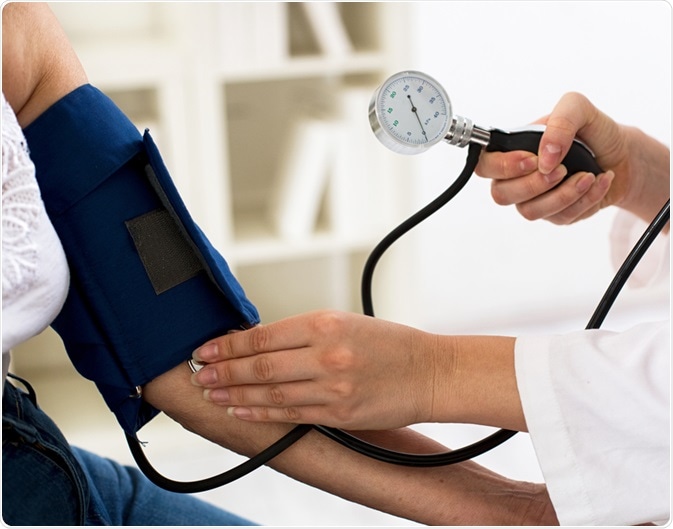Hypotension (low blood pressure) without any symptoms or signs of disease usually does not require treatment. Still, in certain instances general lifestyle advice and treating the underlying cause of the condition is necessary. Pharmacologic measures may be indicated in patients with a lack of appropriate response to conservative therapy for orthostatic hypotension.
 Low Blood Pressure Treatments" />Image Credit: didesign021 / Shutterstock.com
Low Blood Pressure Treatments" />Image Credit: didesign021 / Shutterstock.com
Nonpharmacologic measures
Patients should limit alcohol intake and avoid carbohydrate-rich meals (in order to prevent postprandial hypotension). Adequate hydration must be ensured because fluids increase blood volume, which is important in treating hypotension. Medications that predispose to hypotension should be discontinued.
Older patients should consume at least two liters of fluid per day to balance expected urine losses during a 24-hour period. If orthostatic symptoms are present, rapid water ingestion (i.e. half a liter in four minutes) is often used as a rescue measure to increase systolic blood pressure.
Sodium may be supplemented by adding extra salt to food or taking tablets of salt (a dietary supplement in the form of buffered sodium). All patients on such sodium supplementation should be monitored for edema, weight gain, or eventual heart problems.
An exercise program focused on improving conditioning and teaching physical maneuvers to avoid orthostatic hypotension has proven advantageous. Other useful maneuvers include isometric exercises of the arms, legs and abdominal muscles during positional changes or protracted standing.
Medications for treating hypotension
A synthetic mineralocorticoid fludrocortisone expands plasma volume and increases the sensitivity of blood vessels to noradrenaline, thus remaining sympathetic nerves can induce better vasoconstriction. Dosing should be maintained within the therapeutic range until symptoms are relieved. Potential side-effects of this drug are supine hypertension, headache, hypokalemia and congestive heart failure.
Vasopressor midodrine is effective in treating neurogenic orthostatic hypotension. It increases blood pressure, reduces lightheadedness and increases standing and walking time. The main side-effects can be supine hypertension, tingling sensation in the scalp and goosebumps.
A peripheral selective alpha-1-adrenergic agonist midodrine directly stimulates alpha-receptors and in turn, produces vasoconstriction with a subsequent increase in systolic blood pressure. There is a substantial linear relation between midodrine dosage and mean systolic blood pressure. Adverse effects can include piloerection, itching and tingling sensations.
A cholinesterase inhibitor pyridostigmine improves ganglionic neurotransmission at acetylcholine-mediated neurons in the autonomic nervous system. As this pathway is activated primarily during standing, this drug improves orthostatic hypotension and total peripheral resistance, without aggravating supine hypertension. Adverse effects can include loose stools, abdominal colic, diarrhea and hypersalivation.
In patients refractory to stand-alone treatment, combination therapy can be considered. Ephedra alkaloids and midodrine demonstrate an additive blood pressure effect when combined with a water bolus. In addition, the combination of yohimbine and atomoxetine increases seated blood pressure and improves standing time in peripheral autonomic failure patients.
References
Further Reading